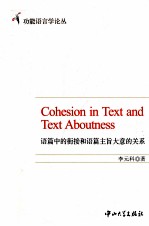

语篇中的衔接和语篇主旨大意的关系 英文PDF电子书下载
- 电子书积分:11 积分如何计算积分?
- 作 者:李元科著
- 出 版 社:广州:中山大学出版社
- 出版年份:2012
- ISBN:7306042538
- 页数:258 页
Chapter 1 Introduction 1
1.1 A short review of studies on cohesion and of aspects of cohesion that have not been explored sufficiently 1
1.2 The aim of my present study 3
1.3 The organization of the book 4
Chapter 2 Literature Background 7
2.1 Introduction 7
2.2 Hasan(1984)and Halliday and Hasan(1985) 7
2.3 The limitations of Hasan's method and improvements 20
2.4 Parsons(1991a,1991b) 36
2.5 Hoey(1991) 41
2.6 Scott's Key Words tool 48
2.7 Hoey's(2001) Textual Interaction 51
2.8 Mann and Thompson's(1988a,1988b)Rhetorical Structure Theory 56
2.9 Conclusions 62
Chapter 3 Research Question 1 and the Method 64
3.1 Introduction 64
3.2 Research question 1 and the data 64
3.3 The method used to explore research question 1 66
3.3.1 Classifying processes in a text into chains according to the commonality of meanings they express 67
3.3.2 Unpacking in text nominalizations that contain nominalised processes included in chains 85
3.3.3 Identifying recurrent nuclei in text 120
3.3.4 Ranking the recurrent nuclei in text in descending order of frequency 127
3.3.5 Classifying processes in summaries into chains according to the commonality of meanings they express 128
3.3.6 Unpacking in summaries nominalizations that contain nominalised processes included in chains 134
3.3.7 Identifying recurrent nuclei in summaries 141
3.3.8 Comparing the results in A4 with that in B3 to identify the recurrent nuclei in text that are repeated in two or more summaries of the text 142
Chapter 4 Findings with Regard to Research Question 1 143
4.1 Introduction 143
4.2 The results with regard to research question 1 143
4.3 The characteristics of the recurrent nuclei in texts that are important to the texts' meanings 151
4.3.1 Category 1 151
4.3.2 Categories 1(c),2 and 3(b) 159
4.3.3 Subcategory 3(a) 164
4.3.4 The probability of presence in the leads of the recurrent nuclei that are important to texts' meanings 167
4.3.5 Category 4 168
4.4 Conclusions 173
Chapter 5 Research Question 2 and Findings 177
5.1 Introduction 177
5.2 The definitions of type A and type B nuclei 177
5.3 Research question 2 and the method of exploring the question 179
5.4 The results with regard to research question 2 191
5.5 Examining the‘maverick' cases 196
5.5.1 The seven initial occurrences of type A material nuclei that express causes 196
5.5.2 The four initial occurrences of type A material nuclei that are part of the content of saying of verbal nuclei 203
5.5.3(a) The initial occurrences of two type A material nuclei that contextualize 208
5.5.3(b) The six initial occurrences of type B material nuclei that also contextualize 211
5.5.4 Proposition splitting 217
5.5.5 Inference 222
5.5.6 Proposition integration 227
5.5.7 Reduction 228
5.5.8 The remaining and final example 231
5.6 Conclusions 232
Chapter 6 Conclusions 236
6.1 Introduction 236
6.2 Areas of innovation and contribution of my present study 236
6.3 Patterns of lexis in a text and the meaning of the text 237
6.4 Information distribution in the leads 239
6.5 The strategies that summary writers often use to write summaries for hard news texts 241
6.6 Conjunctive relations and the meaning of a text 242
6.7 Future research avenues 246
Appendix A 250
Appendix B 252
References 253
- 《SQL与关系数据库理论》(美)戴特(C.J.Date) 2019
- 《公共关系》胡杏菁,罗永全,连伟文主编 2018
- 《齐心开创共建“一带一路”美好未来 在第二届“一带一路”国际合作高峰论坛开幕式上的主旨演讲》习近平著 2019
- 《人际关系应用心理学》贾海泉 2018
- 《初高中化学衔接教材》黄咏梅著 2018
- 《小学一年级预备班幼小衔接语文难点强化提高》稚子文化主编 2014
- 《高校教师胜任力与工作绩效关系研究》曹志峰著 2019
- 《受试者性格与其英语互动交际能力的关系》楼荷英著 2018
- 《初高中英语衔接知识手册精编》杨水霞,张彩云 2017
- 《现代汉语空间位置关系虚拟运动研究》姚京晶著 2018
